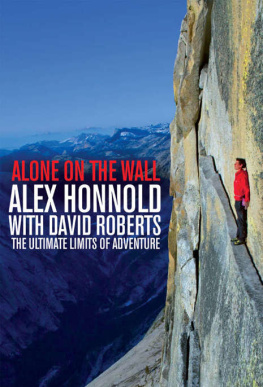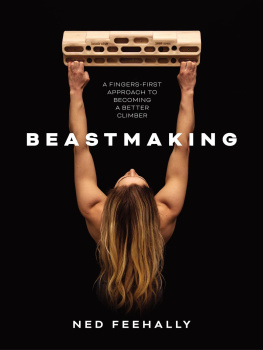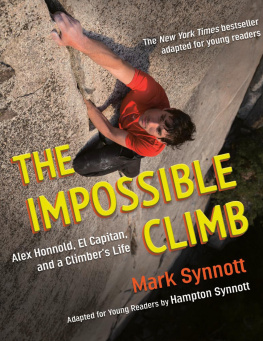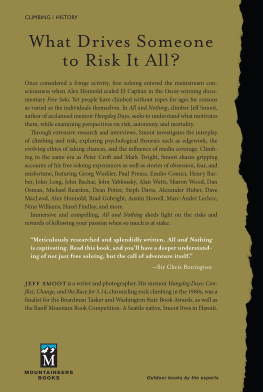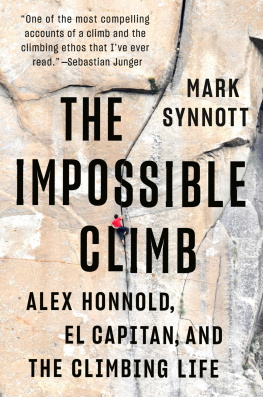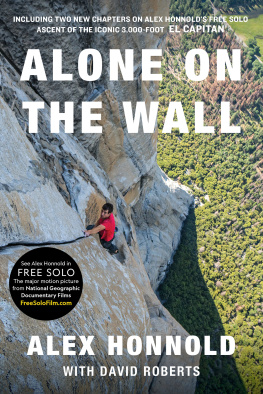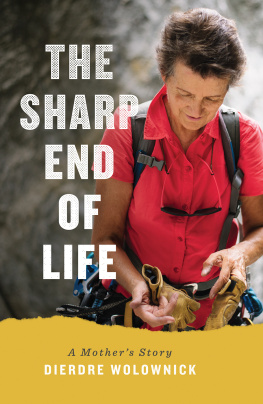ALONE ON THE WALL
Alex No Big Deal Honnold is a professional rock climber whose audacious free-solo ascents have made him one of the most recognized and followed climbers in the world. Honnold has been profiled by 60 Minutes and the New York Times, featured on the cover of National Geographic, and has starred in numerous adventure films, including the Emmy-nominated Alone on the Wall. He is also the founder of the Honnold Foundation, an environmental not-for-profit charity that seeks simple, sustainable ways to improve lives around the world.
David Roberts is co-author, with Conrad Anker, of The Lost Explorer, about the discovery of George Mallorys body on Mount Everest. His most recent book is Alone on the Ice (Norton, 2013).

ALONE
ON THE
WALL
Alex Honnold
with David Roberts
MACMILLAN
To my family, for always supporting me
along an unconventional path
Contents
CHAPTER ONE
MOONLIGHT
I started up the climb shortly after dawn. I wasnt even sure Id found the right start, since I hadnt been on these lower pitches for two or three years. The beginning of the route is kind of scruffy and ambiguousramps, traverses, and hand cracks angling up to the rightbut its not as difficult as the upper two-thirds of the wall.
Still, I was nervous, even a little giddy. It had rained pretty much nonstop the day before, and now the rock was sandy, slabby, and a lot damper than Id hoped. I probably should have waited another day before heading up the route. But I was overpsyched. I couldnt bear the thought of sitting in my van another whole day, thinking the same thoughts I had recycled for the past forty-eight hours. I had to strike while the iron was hot.
Moonlight Buttress is a 1,200-foot-high, nearly vertical sandstone cliff in Utahs Zion National Park. It may be the finestthe purest and most classicroute among Zions thousands of lines. Its also one of the most continuously difficult crack climbs in the world.
The first ascent of Moonlight Buttress came in October 1971, when Jeff Lowe and Mike Weis, two legends of American climbing, pioneered the route. It took them a day and a half, with an overnight bivouac on a ledge in the middle of the wall. They used a lot of aid, pulling or hanging on expansion bolts and pitons.
Nearly twenty-one years later, in April 1992, Peter Croft and Johnny Woodward made the first free ascent, as they took all the aid out of the route by finding sequences of moves they could climb without hanging on gear. They solved the route in nine pitches (rope lengths), but rated the climb a really stiff 5.13a (since downgraded to 5.12d). In 1992, that was near the upper limit of free-climbing difficulty anywhere in the world, and Croft and Woodwards feat was a brilliant one.
Peter Croft was already one of my heroes, because in the 1980s and 90s he had pushed free soloingclimbing without a rope or gear at allto unprecedented extremes. Many of the routes hed free soloed back then had never been repeated in that style during the decades since.
But as far as I knew, no one had even thought of free soloing Moonlight Buttress. Thats what I was hoping to pull off on April 1, 2008.
In the back of my mind was a nagging worry about the feature called the Rocker Blocker. Its an ample ledge, about half the size of a queen-size bed, at the top of the third pitch. Because its loose, somebody has chained it in place with a two-bolt anchor, but it actually makes for a good stance about 400 feet off the ground.
It wasnt the ledge itself that fueled my angst. From the Rocker Blocker, stretching on tiptoe, you can just reach a key hold above. Essentially you face a 5.12c boulder problem right off the ledge. You dont actually have to jump to make the move, but its more like an upward lurch to a small edge. As I climbed the easy pitches down low, that move loomed over me. I was pretty sure I could stick the ledge if I fell off, but Id sure hate to find out.
The day before, sitting in my van in the rain, I had deliberately visualized everything that might happen on the climb. Including breaking a hold, or just losing it and falling off. I saw myself bouncing off the ledge below and going all the way to the ground, fracturing most of my bones as I rag-dolled down the mountain. Id probably bleed out at the base.
I hadnt slept very well the previous night. So I got the early start in the morning that Id planned, hoping to beat the sun to the wall and get cool conditions on the route. To reach the base of Moonlight Buttress, you have to wade the Virgin River, which in early April was freezing-ass cold. I forded the stream barefoot. The rushing water came up above my knees. My feet quickly went numb, and my whole body went into mild shock. Plus I had to pay attention to my balance as I placed my feet carefully in the gaps between polished river cobbles.
At what I thought was the start of Moonlight Buttress, I cached my approach shoes and my daypack. Id decided to carry nothingneither food, nor water, nor spare clothesup the route. I clipped on my chalk bag and laced up my rock shoes. My feet were still cold, but they werent truly numbI could feel my toes all right. I was wearing only shorts and a T-shirt. At the last minute, I put on headphones and turned up my iPod. I was shuffling through my own Top 25 playlist of tunesmostly punk and modern rock.
It may sound lame, but I didnt have a watch, and I was pretty sure I was going to set the speed record for Moonlight Buttress. I could use the iPod to measure the exact number of minutes the climb would take. Music also has a way of helping you focus, although nowadays I prefer to climb without my iPod, because I consider it a bit of a crutch.
For me, free soloing a big wall is all about preparation. In a real sense, I had performed the hard work on Moonlight Buttress during the days leading up to the climb. Once I was on the route, it was just a matter of executing.
Yes, Id climbed the whole route only once before, with a philosophy professor named Bill Ramsey. In his midforties, he was still climbing really well, and hed been working on freeing Moonlight. He recruited me to climb it with him for his free attempt, and we swung leads up the whole route. It was a great day as we both climbed the route clean with no falls.
But that was two or three years earlier. In the days before my free solo attempt, Id focused on the upper 800 feet of the route. Its a mellow hike along a paved trail to the top of Moonlight Buttress, so I hauled up 600 feet of rope, rappelled down it, and practiced the moves on toprope. To self-belay, I used a device called a Mini Traxion, which grips the rope on a downward pull but slides effortlessly up the rope as you climb. If I fell or even rested, the Mini Traxion would hold me tight.
With my toprope, I climbed the upper 600 feet of Moonlight Buttress twice. The crux of the whole routethe hardest single passage, which is the make-or-break stretch of an ascentis an amazing clean inside corner, 180 feet long. Its the fourth of nine pitches on the route, and its what gives the climb its 5.12d rating. Its continuous and really strenuous, so your arms get pretty pumped by the time you reach the top of it.
Each toproped rehearsal of those upper 600 feet had taken me only about an hour. I felt super-solid. At no point did I fall off or even feel sketchy. But then I realized that the 600-foot rope didnt reach down to a crucial 5.11c rightward traverse on the third pitch. So the next day I went back up to the top with 800 feet of rope, rapped down again, and rehearsed the traverse moves until I had them dialed too.
Next page
